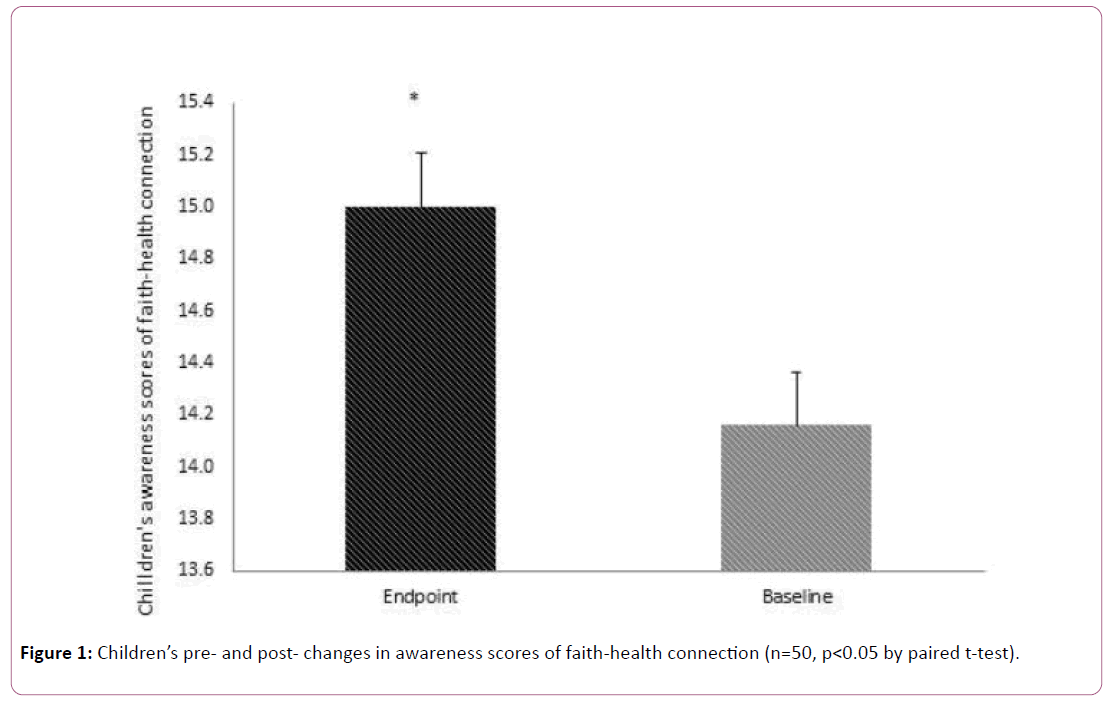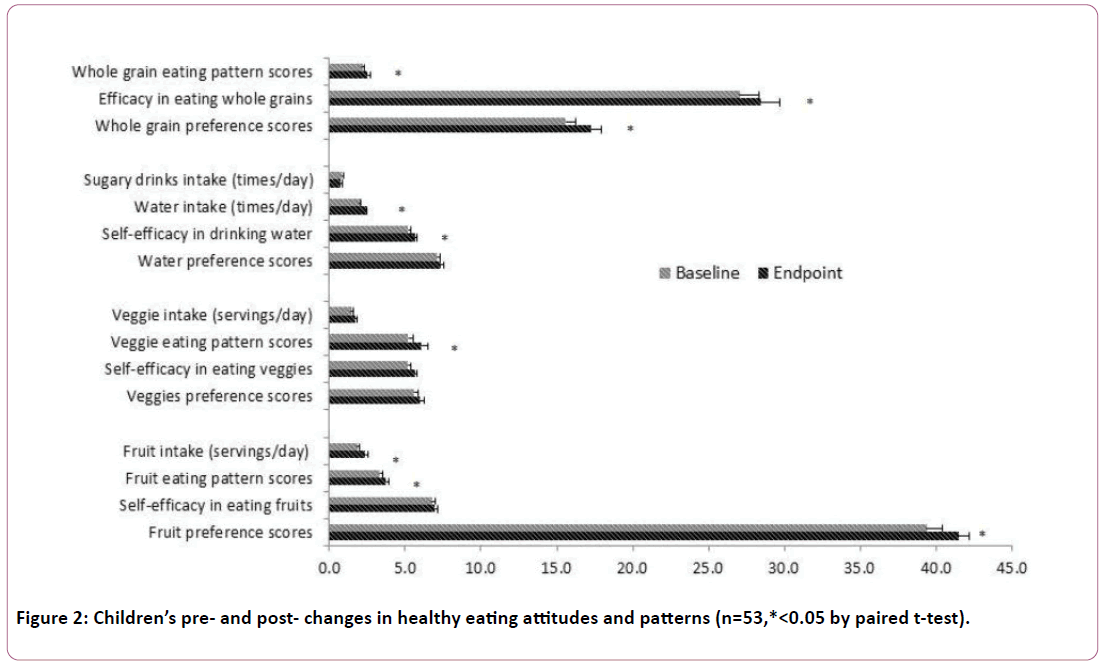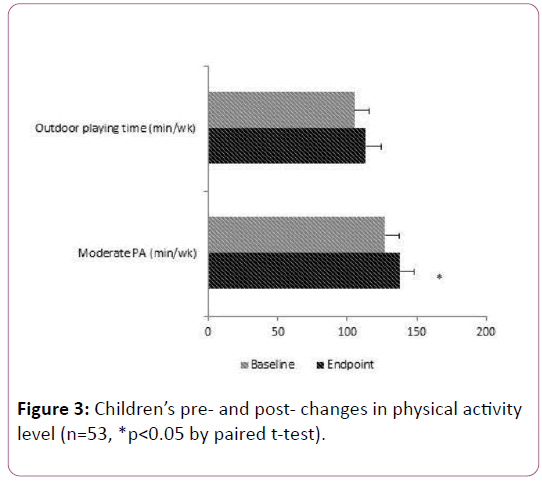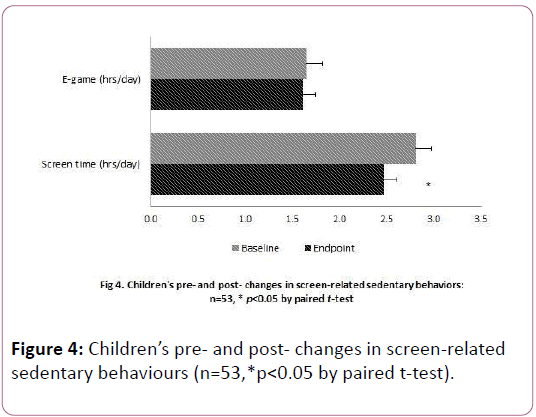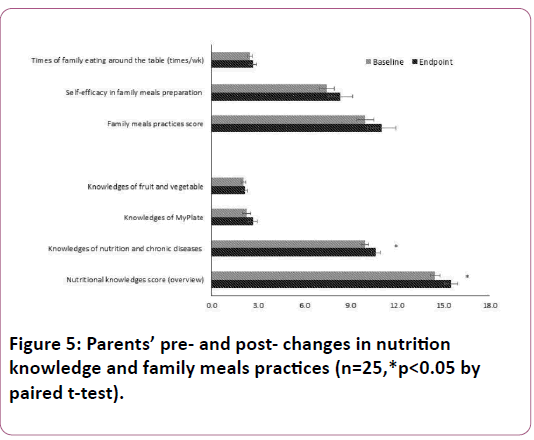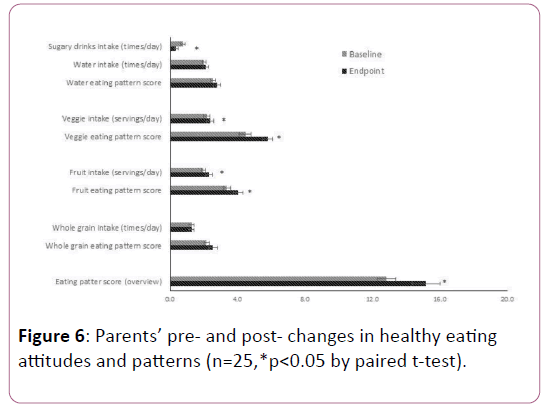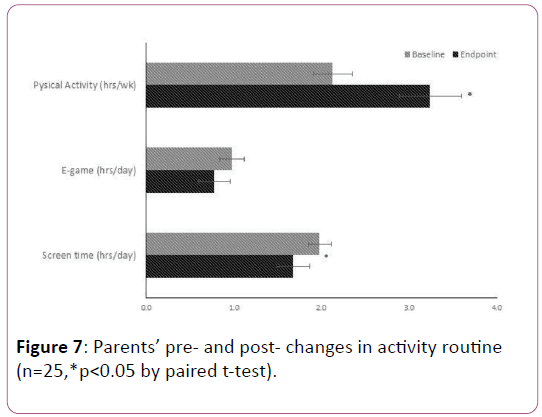Keywords
Childhood obesity; Obesity prevention; Faithbased interventions; Summer camp; Hispanic children
Abbreviations
BHT: Building a Healthy Temple; FV: Fruit and Vegetable; PA: Physical activity; VBS: Vacation Bible School
Introduction
Approximately one-third of U.S. children are either overweight or obese [1]. Hispanic children are among those at greatest risk for obesity, type 2 diabetes and other healthrelated complications [2]. Culturally appropriate obesity prevention programing is needed for Hispanic children disproportionally affected by this health problem. Although schools have been the most common setting for obesity prevention, the impacts of school-based programs were shown to be mixed or relatively modest due to limited success in engaging parents in changing family environment and behaviors toward a healthier lifestyle [3]. Additionally, Hispanic parents may have language barriers that further prevent them from actively interacting with staff in school-based obesity programs. Because parents have strong influences on health-related behaviors of their children, [4,5] targeted intervention programs aimed at parents and families in community settings have been shown to be effective in preventing obesity [6,7].
Recent research found that children increase BMI nearly twice as fast during the summer compared to during the school year; the fast BMI increase was more apparent in low-income Black and Hispanic children than other children [8]. A recent study indicated that children who spend a greater proportion of their summer time in structured environments, e.g., day camp, appear to be more active [9]. To date, summer programs have been shown to be effective in weight reduction among obese children and youth [10-13]. Utilization of a summer program setting for primary obesity prevention is still in its infancy [14].
Faith-based community setting could be an effective venue for childhood obesity prevention by presenting health as an extension of faith [15]. Texas is in the Bible Belt and Vacation Bible School (VBS) is a popular free summer program for many children. VBS could integrate bible study with health promotion to foster growth for the children’s spiritual and physical health. VBS is also a setting where healthy snack and lunch menu options could be further incorporated to reinforce health knowledge learned through healthy bible study. Theme songs and dance in VBS present an opportunity to promote physical activity (PA) while the time that parents pick up their children could be an opportunity for family-oriented nutrition education and cooking demonstrations. As such, a faith-based childhood obesity prevention program “Building a Healthy Temple (BHT) Vacation Bible School (VBS)” Program was developed and pilot tested in three churches Texas in 2016. The current paper describes the BHT VBS intervention and the preliminary findings from the pilot study.
Methodology
BHT VBS program was a multi-component intervention implemented in a church setting for Hispanic children and their families. This pilot program used a pre-post design and targeted children between the age of 6 and 12 enrolled in Vacation Bible School, along with their parents in low-income neighborhoods in San Antonio, Texas, United States. Sample size was calculated. A one-sample paired-t test with an estimate of 67 participants to detect a small intervention effect size of 0.3 in key outcomes at significance of alpha=0.05 and power=80% [16]. The study was approved by the Institutional Review Board (IRB) at the University of Texas at San Antonio.
The BHT VBS Intervention
The Healthy VBS used the theme “Under Construction to Build a Healthy Temple.” The objectives of the program were to increase children’s awareness of caring for their physical wellness as an extension of their faith, thus creating a healthpromoting social norm in faith-based community settings, and to increase the proportion of Hispanic families who are practicing healthy eating and physical activity. Modeled after a traditional VBS program, the intervention used multipronged strategies to engage children and families in adopting a healthy lifestyle. These strategies included “Healthy VBS Curriculum,” “Hands-on Healthy Snack Activities,” “Healthy Meals and Healthy Eating Competition,” “Fit for the Lord,” and “Health Education with Cooking Demonstrations for Parents”. Each set of strategies included five lessons, lasting approximately one-hour each, to fit with a traditional one-week long VBS. Lessons were designed to be implemented as a circuit, where groups of children would rotate through stations set up for each component. It was expected that Healthy VBS curriculum would increase children’s awareness of the importance of living a healthy lifestyle as an extension of their faith. The health messages throughout the curriculum would increase children’s knowledge regarding the important concepts including, but not limited to, increasing FV intake; consuming whole grains, instead of refined grains; drinking water, instead of sweetened beverages; controlling food portion; and increasing PA level. The Hands-on Healthy Snack activities would improve children’s skills in making healthy food choices, while health Lunch Menus and the lunch-room Healthy Eating Competition improve children’s eating patterns. Parental Health Education and Cooking Demonstrations would further engage the family in making healthy lifestyle changes. Daily theme songs and dance, as well as fun PA, would improve children’s PA skills and increase their PA levels. All intervention strategies were implemented by trained VBS teachers, staff, and volunteers from each participating church.
Healthy VBS curriculum
The curriculum incorporated scripture readings, health messages, prayers and activities that delivered culturally appropriate healthy messages to better children’s understanding of and increase both their responsibility and skills in making healthy choices. Each lesson started and closed with a prayer. Children participated in scripture readings, reflections, and hands-on health-promoting activities. Each lesson also included healthy craft activities to reinforce children’s learning. For example, children used cardboard pieces to build a healthy temple with pillars labeled “whole grains,” “fruits and vegetables,” “low-fat dairy,” “lean meat,” “water,” and “physical activity”.
Hands-on healthy snack activities
Healthy snacks were offered every day through the VBS. The Hands-on Healthy Snack Activities were designed to coincide with the health topics covered in the VBS lessons. Trained VBS staff prepared for and supervised children in making healthy snacks (e.g., decoration of water bottles for drinking pure water, making banana whole grain sandwiches, putting together a fruit and vegetable (FV) rainbow plate, making a healthy smoothie, etc.).
Healthy meals and healthy eating competition
Based on the United States Department of Agriculture Guidelines, a 5-day healthy meal menu reinforcing the health messages from the VBS lessons were provided to VBS kitchen staff. The menu included FV, whole grain-rich foods, fat-free or low-fat milk varieties, and foods low in sodium and trans-fat. Children were encouraged to participate in a lunchroom Healthy Eating Competition to win happy face stickers for eating healthy food items (such as FV, whole grain, and water, etc.).
Recognitions and small rewards were given to 3-5 winners each day.
Fit for the lord
A physical activity manual containing a set of theme songs and dances, as well as age-appropriate activities were implemented by trained VBS staff.
Health education with cooking demonstrations for parents
A series of health fair style posters with cue cards entitled “9-5-2-1-0 for a Healthy Temple” were developed to educate parents on healthy living tips for their children. The key messages promoted were “9 hours of sleep per day,” “0.5- filling half of the plate with fruits and veggies,” “2-hour limit on screen time per day,” “1-hour of physical activity per day,” and “0 sugaradded beverages per day”. The trained VBS staff presented the posters using the scripts on the cue cards to parents at pick-up time. Cooking demonstrations and recipe cards were incorporated to improve parental skills in cooking healthful foods.
Recruitment
Recruitment occurred at two levels, i.e., church and individual level. BHT VBS promotion materials were distributed to churches in San Antonio’s low-income areas in the spring at the time churches were deciding their VBS curriculum for the year. Research staff called or visited to address questions from interested congregations. Once a congregation agreed to participate, Research staff scheduled training sessions for VBS staff and teachers. Each church held a mandatory registration day event where both children and parents attended to formally enroll in VBS. At this registration day event, parents completed all paperwork required by the church to participate. All children enrolled for VBS were informed of the BHT VBS program and invited for voluntarily participation in evaluation. Informed consent from parents and an assent from children were obtained prior to data collection. Children without consent were allowed to take part in the BHT VBS program; no data were collected from them. At the registration event, both children and parents volunteering to participate in evaluation were asked to complete a healthy lifestyle survey. Trained bilingual program staff unaffiliated with VBS participants assisted children and parents in survey completion.
Data Collection
A pre- and post- one-group design was used to evaluate intervention effect through self-administrated questionnaires at baseline and one-week post-intervention. Outcome measures included children’s awareness of the faith-health connection, food intake, eating patterns, self-efficacy on healthy eating, food preference, and physical activity (PA) level. Parental knowledge and attitude toward healthy living, as well as eating and PA patterns were measured.
The child questionnaire consisted of questions assessing their awareness and attitude of caring for God’s Temple, self-efficacy for healthy eating, preference on FV, water, and whole grains, perceived ability to make healthy snacks at home as well as their eating and physical activity patterns. Children’s awareness and attitude of caring for God’s Temple were assessed by a set of eight questions developed by the current research team. These questions include “My body is God’s Holy Temple”; “I want to take good care of God’s Temple”; “Regular physical activities strengthen God’s Temple”; “At Creation, God granted us plant source foods”; “After Man Fall, God allowed us to eat animal foods”; “By drinking water and eating fruit and vegetables, Daniel was stronger and healthier than those eating royal feasts”; “Soda and sugary drinks may damage God’s Temple” and “Gluttony is a sin”. Three answer options were given to each of these questions: “disagree”; “no sure” or “agree”. For each question, the score ranged from 0 to 2 (0 for disagree; 1 for not sure and 2 for agree). This 8-item scale yielded a Cronbach's Alpha of 0.67 (p<0.05) in the current study sample. The Pro- Children Questionnaire was adapted to measure children’s selfefficacy for eating fruit, vegetables, whole grain and water [17]. The 13-item healthy eating self-efficacy scale had a Cronbach's Alpha of 0.76 (p<0.05) in the current study. Children’s food preference was measured by adapting a computerized instrument assessing fruit and vegetables preference [18]. The instrument measures children’s preference of fruits, vegetables and juices by asking them if the food item tasted “yummy,” “yucky,” or just “okay” using facial expression (happy face for yummy, unhappy face for yucky, neutral face for okay) on the screen. The instrument shows adequate test-retest reliability (r=0.70; p <0.01) and internal consistency of FJV items (Cronbach alpha=0.87) [18]. Due the constraint of using computer in community-setting, the current study used a paper copy with the same questions, answer options and facial expression. Two additional questions regarding water and whole grains were added into the testing process. The food preference measure was scored by averaging participants’ responses in each category [18]. The measure can be used to yield an overall food preference score or to yield separate preference scores for fruits, fruit juices, vegetables, water and whole grains. Each food preference score ranged from 0 to 2 (0 for “yucky,” 1 for “okay,” and 2 for “yummy”) [18]. Children’s eating patterns were assessed using the Food Behavior Checklist focusing on sweetened beverages, water, fruit, vegetables, and whole grain consumption [19]. Children’s screen viewing time was assessed using two questions: “I usually watch TV, DVDs or movies __ hours a day” and “I usually play video or computer games__ hours a day”. Children’s physical activity level was measured via two questions “Last week, 3. Last week, I exercised or took part in physical activity that made my heart beat fast and made I breathe hard for at least 30 minutes for ___ days” and “Last week, I played outdoors for 30 minutes or more for __days”.
Parents also completed a questionnaire about their nutrition knowledge, cooking practices and family eating pattern as well as brief family demographic information. Parents’ nutrition knowledge was assessed by asking their opinion the linkage between healthy eating and risks of chronic diseases; the importance of maintaining a healthy bodyweight, knowledge of MyPlate, and the recommended number of servings for each food group set forwarded by the Dietary Guidelines. Parents’ cooking and family eating practice was assessed by two questions” over the past week, how many times did you make healthy dishes that you learn from cooking demonstrations?” and “how many times did all, or most, of your family eat lunch/ dinner around the table?”. The answers options were “Never”; “1-2 times per week”; “3-4 times per week”; “5-6 times per week” or “7 times or more per week”. Parents’ eating patterns were assessed using the Food Behavior Checklist focusing on sweetened beverages, water, fruit, vegetables, and whole grain consumption [18]. Parents screen time was assessed by two questions “2. On an AVERAGE DAY, how many hours do you watch TV/DVDS/Movies” and “on an AVERAGE DAY, how many hours do you play video or computer games or use a computer/ tablet for something that is not related to work?” Parents’ physical activity patterns were measured with a single question “during the PAST 7 DAYS, how many days were you physically active for AT LEAST 60 MINUTES per day?”
Data Analysis
Data were entered into SPSS Version 22. Children’s faith and health connection score was calculated by summing up the responses from the 8-item scale ranging from 0 to 16. Children’s self-efficacy scores were calculated for their confidence to consume fruit, vegetable, water and whole grains, respectively. Children’s preference scores were calculated for fruit, vegetables, water, and whole grains, separately. Children’s fruit eating behavior were scored for eating fruit, vegetables and whole grain by summing up their consumption patterns. Moderate physical activity level and outdoor play time were calculated by multiplying 30 minutes with the reported number of active days. Parents’ nutrition knowledge scores, cooking practice scores and family eating patterns were calculated by summing up their responses, respectively. Children and parents who had both baseline and endpoint values were included in the analysis for each variable. Student paired t-test was performed to compare pre and post changes in intervention outcomes, e.g., awareness of the faith-health connection, self-efficacy on healthy eating, food preference, eating patterns and PA level. The level of significance for all statistical tests was set at 0.05.
Results
Within the 315 participating children in three BHT VBSs, parental consent and child assent were obtained from 114 children for intervention outcome assessment at baseline, and 53, returned to complete endpoint data collection one week after the VBS. The study subjects consisted of 21 boys and 32 girls with a mean age of 9.3 (± 2.9).
Impact of VBS intervention on children
Impact of VBS intervention on children’s awareness scores regarding faith-health connection: The impact of BHT VBS on children’s awareness of caring for physical well-being as an extension of their faith was assessed using an 8-quesiton set with a three point likert-scale (disagree=0, not sure=1, agree=2). An awareness score was calculated by summing up 8 responses (0-16). Figure 1 shows that children significantly increased awareness scores of faith-health connection (p<0.05).
Figure 1: Children’s pre- and post- changes in awareness scores of faith-health connection (n=50, p<0.05 by paired t-test).
Impact of VBS intervention on children’s eating attitude and behaviors improvement: BHT VBS intervention resulted in significant favorable changes in children’s eating pattern (Figure 2). Compared to baseline, children significantly improved their preference for fruit and whole grains.
Figure 2: Children’s pre- and post- changes in healthy eating attitudes and patterns (n=53,*<0.05 by paired t-test).
Their self-efficacy scores for drinking more water and eating whole grains significantly increased at endpoint. The program also resulted in a significant increase in eating patterns scores for fruit and vegetables (FV) and whole grains. Children’s daily fruit consumption significantly increased by 0.5 servings and daily water increased by 0.4 times.
Children’s increased moderate PA level, as well as decreased screen-related sedentary behaviors: The BHT VBS resulted in a significant increase in children’s weekly moderate PA level (Figure 3) and a significant reduction in daily screen time (Figure 4).
Figure 3: Children’s pre- and post- changes in physical activity level (n=53, *p<0.05 by paired t-test).
Figure 4: Children’s pre- and post- changes in screen-related sedentary behaviours (n=53,*p<0.05 by paired t-test).
Impact of VBS intervention on parents
Among the 80 parents who participated in parent education, 60 gave informed consent to take part in intervention outcome assessment at baseline. Only 25 returned to complete endpoint data collection one week of the VBS. These participants consisted of 24 women and one man with a mean age of 45.5 (± 12.7).
Impact of VBS intervention on parents’ nutrition knowledge score and family meal practices: Parents significantly increased their overall nutrition knowledge scores and knowledge scores of nutrition and chronic disease prevention (Figure 5). Although not significant, there is a trend of improved family meal practices including frequency of family eating dinner around the table, self-efficacy in family meal preparation and family meal practice score.
Figure 5: Parents’ pre- and post- changes in nutrition knowledge and family meals practices (n=25,*p<0.05 by paired t-test).
Impact of VBS intervention on parents’ eating attitude and behaviors improvement: Significant favorable changes were observed in parents’ eating patterns (Figure 6). Compared to baseline, both FV eating pattern scores and FV intake significantly increased. Parents also improved their drinking behaviors by reducing the frequency of daily sugary drink consumption by more than half (p<0.05). Although not statistically significant, there is an increased trend for water drinking pattern and water consumption, as well as whole grain eating pattern score.
Figure 6: Parents’ pre- and post- changes in healthy eating attitudes and patterns (n=25,*p<0.05 by paired t-test).
Parents' increased PA level, as well as decreased screenrelated sedentary behaviors: Upon the completion of the BHT VBS intervention, parents significantly increased their weekly PA level and reduced their daily screen time (Figure 7).
Figure 7: Parents’ pre- and post- changes in activity routine (n=25,*p<0.05 by paired t-test).
Discussion
The current pilot study was the first of its kind to integrate multi-pronged intervention into existing religion summer program, i.e. Vacation Bible School, in the Bible belt in the United States of America. Although brief, the BHT VBS resulted in favorable lifestyle changes in both children and parents, which will lead to the adoption of a healthier lifestyle for Hispanic families within the faith community. Obesity prevention programing through the faith community appears promising and practical when designed to suit the traditional religion programs that serve a large number of children and their families. A holistic approach through the integration of spiritual and health promotion could contribute the nation’s comprehensive childhood obesity prevention efforts, especially for minority children disproportionally affected by this health problem.
Faith-based communities have been an emerging venue for health promotion over the past two decades [20]. However, many of the health promotion programs taking place in a faith setting are considered faith-placed, solely using the church as a place for health program delivery [21]. Utilizing a true faithbased approach includes the integration of a spiritual dimension to accompany program delivery [21]. In the faith-based context, health can be viewed as a dynamic reflection of one’s connection with faith, and actions towards improving one’s health, as an opportunity to honor God [21]. Faith-based approaches, which relate new behaviors to an individual’s preexisting values, knowledge, and practices, may result in more beneficial and sustainable outcomes. Church leaders agree that obesity prevention programming in faith-settings is both feasible and necessary, but must incorporate a spiritual dimension that integrates faith and health [22]. Our findings regarding the significant increase in children’s faith and health connection suggest that children can learn this connection in the faith-based setting. In the context of the BHT VBS program, this is done through incorporation of scripture mixed with health education and prayer within the Healthy VBS Curriculum. Although BHT VBS resulted in favorable outcomes, VBS may not be as popular outside of the Bible belt. In addition, VBS traditionally lasts for one week. Future health programming in faith settings should consider incorporating continuous health promotion messaging through existing religious practices (e.g., Sunday school) to sustain VBS program outcomes. Although the linkage of faith and health can be promising in facilitating health behavioral changes, health professional should be mindful of the potential undesirable psychological effect this might have on children. Since lifestyle change is a lengthy process and may not be immediately accomplishable, children might experience a sense of internal guilt if they did not achieve their desired health outcome. Faith-based interventions should encourage children to do their best while recognizing the needs for persistent efforts without blaming themselves. Additionally, linking faith and health has potential to have both positive and negative outcomes. While the majority of literature focuses on the positive associations between faith and health, negative interaction generally on focuses on social interactions with congregants and clergy [23-25]. It is possible that an intervention may affect an individual’s relationship with God either positively or negatively. There has been no research conducted on the moderating or mediating effects of religious/ spirituality measures and health program outcomes, and vice versa. Future health promotion programming in faith-settings should strive to include these measures (e.g., Schieman’s ‘Sense of Divine Control’ and Krause’s ‘Closeness to God’ constructs) to explore their relationship, monitor for changes through and after intervention, and rule out potential negative implications on children’s faith [24,26].
It is encouraging that the brief BHT VBS resulted in favorable changes in children’s self-efficacy in healthy eating, preference toward healthful foods including fruit, water and whole grains with a shift from feeling “Yucky to ‘Yummy’. Children’s eating behaviors also improved as reflected by increasing fruit and water consumption, and eating patterns scores for FV and whole grains. Research has shown that children’s exposure to healthful foods led to favorable changes in food preference [27]. Our findings echo research in both preschool and school-aged children [28-30]. It was suggested that ‘exposure’ is a promising technique for improving children’s liking of healthful foods [27]. In the current context, we used Hands-on Healthy Snack Activities coinciding with topics in the Health VBS Curriculum, along with serving Healthy Meals, and Healthy Eating Competition. These strategies may all contribute to the favorable changes in healthful food self-efficacy, preference and eating patterns. It is worthy to note that although the current intervention resulted in improved children’s preference score and efficacy score for vegetables, the improvement was not statistically significant Research has suggested it appears more challenge to promote vegetables than fruit due to the fact that fruits were easily accepted by children because of the sweet flavor [31]. Children’s disliking the tastes of vegetables presents a challenge to promoting vegetable consumption, which required parental role modeling, creative cooking to incorporate vegetables to children’s diet, along with nutrition education [31]. Our BHT VBS was too brief to result in significant changes in children’s self-efficacy and preference toward vegetables. Ongoing vegetable promotion involving children and their families, as well as the faith community at large, e.g., offering vegetables at congregation gatherings could be effective strategies in favorably changing children’s vegetable preference and intake.
It is encouraging that the BHT VBS increased children’s physical activity level while it decreased their screen time. Physical inactivity and sedentary behavior is one of the major childhood obesity risk factors. Extensive television (TV) viewing and computer use have been consistently associated with overweight and obesity in children in North America [32-37]. Efforts to increase children’s energy expenditure are equally important as healthy eating promotion, and potentially may have additional positive short- and long-term benefit. For instance, in addition to decreasing the potential for overweight and obesity immediately and later in life, children who are regularly physically active also tend to experience attitude and behavioral improvements and some researchers have identified a positive correlation between exercise and academic achievement, children’s self-esteem and self-efficacy [38]. Lowincome Black and Hispanic children tend to increase BMI nearly twice as fast during the summer compared to during the school year, in part, due to a lack of affordable physical activity opportunities such as physical activity summer camps [8,10-13]. VBS is a free summer program offered by many churches to church-going and non-going children and youth. The presence of safe physical activity space and facilities within church properties offer opportunities for the integration of fun physical activities into VBS via the faith-health connection theme of “fit for the Lord”. Once physical activity becomes part of the religious norm, on-going physical activity promotion could engage children, youth, and adults in the faith community settings.
The BHT VBS seized the opportunity of engaging parents and extended families in healthy lifestyle promotion. The health fair style education, along with cooking demonstration and food sampling has produced favorable outcome. Parental role modeling of healthy living plays a key role in developing healthy habits for obesity prevention in children. Research suggests that family and social support are of even greater importance for Hispanic communities [39]. In addition, parents are the nutritional gatekeepers for children. Parents should be regarded as agents of change: improving the health habits of parents can effectively change health behaviors and outcomes in their children [6,7]. Traditional school-based and summer camp health promotion programs often report difficulty engaging parents of participating children [3]. In the context of this study, we engaged parents through Health Education with Cooking Demonstrations. BHT VBS shows great promise in improving parents eating patterns and physical activity level. This suggests that faith-based programs may be more successful in engaging family as a whole. In agreement with previous research, future faith-based health promotion programs should aim to engage both children and their parents, incorporating a family-oriented approach [40,41]. Although effective in improving parents' nutrition knowledge, cooking practice and eating patterns, the intervention was brief which may not result in lasting changes. Future health promotion programming should consider longterm engagement of the whole family through efforts that extend beyond the one-week VBS within the close-knit supportive environment in faith community settings.
Study strengths and limitations
The strength of this study lies in our use of a non-traditional venue and approach for promoting healthy lifestyles among high-risk Hispanics. There are four main innovative features used: 1) integrating the promotion of spiritual and physical health; 2) using existing infrastructure and social support systems in church settings to deliver programs that facilitate healthful behavioral changes; 3) building community capacity by using the Train-the-Trainer Model. The trained VBS staff and teachers will remain in the community as important human capital to sustain health promotion services and activities; and 4) strengthen partnership among academics, the faith-based community, and key community stakeholders and advocates.
There were a number of limitations to this pilot study. First, a one-group pre-post design was used in evaluating the impacts of the program. Although such a design is considered suitable for a pilot study, it may have compromised internal validity. Second, the sample size was relatively small which may decrease statistical power in evaluating intervention outcomes. Future large-scale implementation and evaluation of BHT VBS should use an attention control trial or delayed intervention design with larger sample size. Third, while every effort was made to reduce bias, parents, children, and VBS staff were present at data collection events, social desirability may have influenced children’s responses on surveys. Fourth, the program is short duration, one-week. Follow-up evaluation is needed in future studies to investigate program effect sustainability through then end of the summer. Additionally, future programs should aim to integrate obesity prevention strategies into ongoing religious activities in faith communities, which may lead to healthy body weight and reduction in the prevalence of obesity. Fifth, the pilot study did not was not large enough to investigate cluster effect for the participating churches. Future studies with larger samples from multiple churches should consider cluster analysis in their design effect when calculating sample size needed for significance.
Conclusions
BHT VBS addresses obesity disparities among Hispanics by implementing multi-pronged intervention strategies through popular religious summer programs in the Bible belt. Although brief, BHT VBS’s holistic approach integrating spiritual and physical health promotion has led to favorable changes in awareness, attitude, preference, self-efficacy, eating and physical activity patterns toward a healthier lifestyle in both children and parents. BHT VBS appears to be one of the promising approaches to curb the national childhood obesity epidemic, especially for Hispanic children disproportionally affected by this problem. This study exemplified an initial step that warrants further examination of sustained behavior changes and health outcomes in both children and parents.
Acknowledgements
This study was jointly funded by Blue Cross Blue Shield of Texas, Saint Susie Charitable Foundation and Baptist Heath Foundation of San Antonio. The authors are grateful for Dr. Luz- Myriam Neira. Director Nutrition, Health & Wellness Division at San Antonio Food Bank for their partnership in providing cooking training to VBS staff. Especial thanks are extended to the leaders, teachers, staff, volunteers and participants of the participating Vacation Bible Schools.
Funds
Funds to conduct this research were provided by Blue Cross Blue Shield of Texas and Saint Susie Charitable Foundation.
Conflict of Interest
The authors have no conflicts of interest to declare.
References
- Ogden CL, Carroll MD, Kit BK, Flegal KM (2012) Prevalence of obesity and trends in body mass index among US children and adolescents, 1999-2010. JAMA 307: 483-490.
- Flegal KM, Ogden CL, Carroll MD (2004) Prevalence and trends in overweight in Mexican-American adults and children. Nutr Rev 62: S144-S148.
- Gittelsohn J, Kumar MB (2007) Preventing childhood obesity and diabetes: Is it time to move out of the school? Pediatr Diabetes 8 Suppl 9: 55-69.
- Klesges RC, Stein RJ, Eck LH, Isbell TR, Klesges LM (1991) Parental influence on food selection in young children and its relationships to childhood obesity. Am J Clin Nutr 53859-864.
- Contento IR, Basch C, Shea S, Gutin B, Zybert P, et al. (1993) Relationship of mothers' food choice criteria to food intake of preschool children: Identification of family subgroups. Health Educ Q 20: 243-259.
- Golley RK, Magarey AM, Baur LA, Steinbeck KS, Daniels LA (2007) Twelve-month effectiveness of a parent-led, family-focused weight-management program for prepubertal children: A randomized, controlled trial. Pediatrics 119: 517-525.
- Beech BM, Klesges RC, Kumanyika SK, Murray DM, Klesges L, et al. (2003) Child-and parent-targeted interventions: The Memphis GEMS pilot study. Ethn Dis 13: S40-S53.
- Downey DB, Boughton HR (2007) Childhood body mass index gain during the summer versus during the school year. New Dir Youth Dev: 33-43.
- Tovar A, Lividini K, Economos CD, Folta S, Goldberg J, et al. (2010) School's out: What are urban children doing? The Summer Activity Study of Somerville Youth (SASSY). BMC Pediatr 10: 16.
- Huelsing J, Kanafani N, Mao J, White NH (2010) Camp jump start: Effects of a residential summer weight-loss camp for older children and adolescents. Pediatrics 125: e884-e890.
- Wong WW, Abrams SH, Mikhail C, Terrazas NL, Wilson TA, et al. (2009) An innovative summer camp program improves weight and self-esteem in obese children. J Pediatr Gastroenterol Nutr 49: 493-497.
- Gately PJ, Cooke CB, Butterly RJ, Mackreth P, Carroll S (2000) The effects of a children's summer camp programme on weight loss, with a 10 month follow-up. Int J Obes Relat Metab Disord 24: 1445-1452.
- Southam MA, Kirkley BG, Murchison A, Berkowitz RI (1984) A summer day camp approach to adolescent weight loss. Adolescence 19: 855-868.
- Baranowski T, Baranowski JC, Cullen KW, Thompson DI, Nicklas T, et al. (2003) The Fun, Food, and Fitness Project (FFFP): The Baylor GEMS pilot study. Ethn Dis 13: S30-S39.
- https://www.rwjf.org/en/library/articles-and-news/2009/01/faith-based-coalitions-to-combat-childhood-obesity.html
- Rosner B (1995) Fundamentals of Biostatistics. 4th edn. Duxbury Press. 221.
- De Bourdeaudhuij I, Klepp KI, Due P, Rodrigo CP, de Almeida M (2005) Reliability and validity of a questionnaire to measure personal, social and environmental correlates of fruit and vegetable intake in 10-11-year-old children in five European countries. Public Health Nutr 8: 189-200.
- Jaramillo SJ, Yang SJ, Hughes SO, Fisher JO, Morales M, et al. (2006) Interactive computerized fruit and vegetable preference measure for African-American and Hispanic preschoolers. J Nutr Educ Behav 38: 352-359.
- Blackburn M, Townsend M, Kaiser L, Martin A, West E, et al. (2006) Food behavior checklist effectively evaluates nutrition education. Calif Agr 60: 20-24.
- Brudenell I (2003) Parish nursing: Nurturing body, mind, spirit, and community. Public Health Nurs 20: 85-94.
- DeHaven MJ, Hunter IB, Wilder L, Walton JW, Berry J (2004) Health programs in faith-based organizations: Are they effective? Am J Public Health 94:1030-1036.
- He M, Wilmoth S, Bustos D, Jones T, Leeds J, et al. (2013) Latino church leaders' perspectives on childhood obesity prevention. Am J Prev Med 44: S232- S239.
- Rook KS (1984) The negative side of social interaction: Impact on psychological well-being. J Pers Soc Psychol 46: 1097-1108.
- Krause N (2002) Exploring race differences in a comprehensive battery of church-based social support measures. Rev Religious Res 44: 126-149.
- Hummer RA, Ellison CG, Rogers RG, Moulton BE, Romero RR (2004) Religious involvement and adult mortality in the United States: Review and perspective. South Med J 97:1223-1230.
- Schieman S, Pudrovska T, Pearlin L, Ellison C (2006) The sense of divine control and psychological distress: Variations across race and socioeconomic status. J Sci Study Religion 45: 529-549.
- Schindler JM, Corbett D, Forestell CA (2013) Assessing the effect of food exposure on children's identification and acceptance of fruit and vegetables. Eat Behav 14: 53-56.
- Wardle J, Herrera ML, Cooke L, Gibson EL (2003) Modifying children's food preferences: The effects of exposure and reward on acceptance of an unfamiliar vegetable. Eur J Clin Nutr 57: 341-348.
- Taylor J, Binns D, Smith H, Gallant HJ, Crozier P (2003) Evaluation of a fruit & vegetable pilot program for elementary school children in Prince Edward Island. Prince Edward Island: Prince Edward Island Healthy Eating Alliance.
- Noradilah MJ, Zahara AM (2012) Acceptance of a test vegetable after repeated exposures among preschoolers. Malays J Nutr 18: 67-75.
- Nepper MJ, Chai W (2017) Parental views of promoting fruit and vegetable intake among overweight preschoolers and school-aged children. Glob Qual Nurs Res 4: 2333393617692085.
- Hanley AJ, Harris SB, Gittelsohn J, Wolever TM, Saksvig B, et al. (2000) Overweight among children and adolescents in a Native Canadian community: Prevalence and associated factors. Am J Clin Nutr 71: 693-700.
- Robinson TN (2001) Television viewing and childhood obesity. Pediatr Clin 48: 1017-1025.
- Hernández B, Gortmaker SL, Colditz GA, Peterson KE, Laird NM, et al. (1999 ) Association of obesity with physical activity, television programs and other forms of video viewing among children in Mexico City. Int J Obes 23: 845.
- Dennison BA, Erb TA, Jenkins PL (2002) Television viewing and television in bedroom associated with overweight risk among low-income preschool children. Pediatrics 109: 1028-1035.
- Lowry R, Wechsler H, Galuska DA, Fulton JE, Kann L (2002) Television viewing and its associations with overweight, sedentary lifestyle, and insufficient consumption of fruits and vegetables among US high school students: Differences by race, ethnicity, and gender. J Sch Health 72: 413-421.
- Eisenmann JC, Heelan KA, Welk GJ (2004) Assessing body composition among 3- to 8-year-old children: Anthropometry, BIA, and DXA. Obes Res 12: 1633-1640.
- Canadian Paediatric Society (2002) Healthy active living for children and youth. Paediatr Child Health 7: 347-362.
- Ramirez AG, Chalela P, Gallion K, Velez LF (2007) Energy balance feasibility study for Latinas in Texas: A qualitative assessment. Prev Chronic Dis 4: A98.
- Campbell K, Waters E, O'Meara S, Kelly S, Summerbell C (2002) Interventions for preventing obesity in children. Cochrane Database Syst Rev: CD001871.
- Summerbell CD, Waters E, Edmunds LD, Kelly S, Brown T, et al. (2005) Interventions for preventing obesity in children. Cochrane Database Syst Rev: CD001871.

